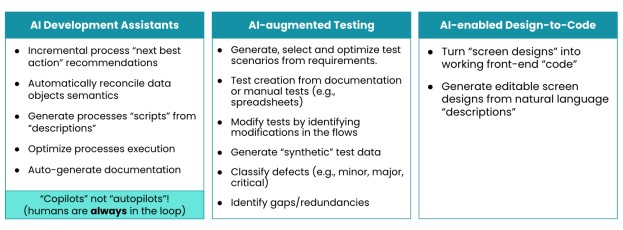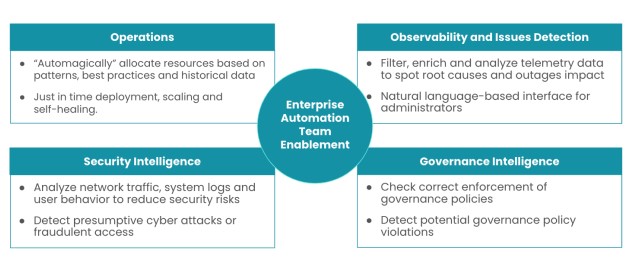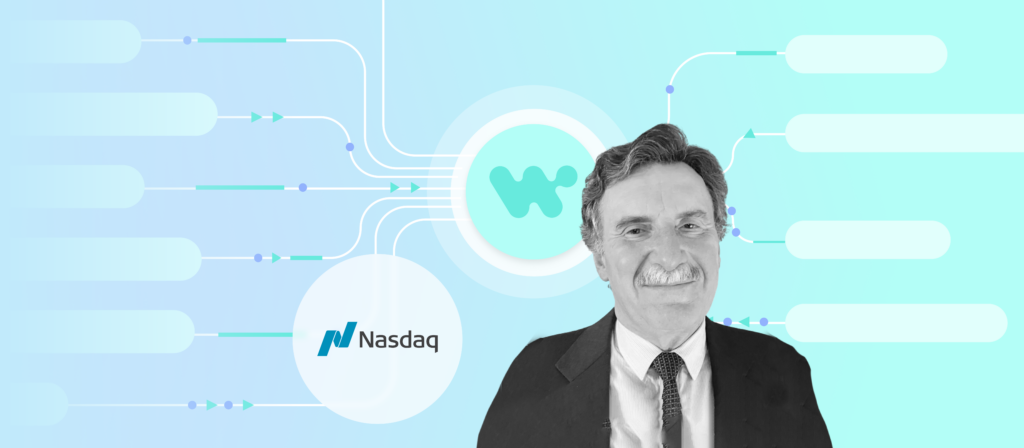Originally featured on nasdaq.com here
In the New AI-centric Integration Use Cases Will Boost iPaaS Adoption article, published on nasdaq.com in June 2024, we analyzed how, in our opinion, the AI megatrend at play is good news for the iPaaS market. Widespread AI, including Gen AI, adoption by user organizations is favoring the emergence of a number of new, AI-centric automation and integration scenarios, which CIOs and IT leaders will have to tackle as they venture in the AI world. They can address these scenarios in many different ways. However, we expect iPaaS will emerge as the platform of choice because of its versatility, ease-of-use, widespread adoption, support for IT and non-IT users, and popularity among both midsize and large organizations.
In this follow up article, we want to look at the relationship between AI and iPaaS from another perspective: how will iPaaS providers leverage AI technologies to improve their products? What are the benefits user organizations will be able to experience? How will AI impact the iPaaS competitive scenario in particular in the enterprise market?
1. Gen AI-assisted iPaaS Development
The relationship between AI and iPaaS is well established and has been going on for several years. Many iPaaS providers have been successfully leveraging ML, and other AI techniques, to assist automation and integration flow development. For example, by providing builders with ML-enabled suggestions about what is likely to be the “next logical step” in the flow they are developing (for example, order-to-cash). Many iPaaS also feature ML-powered capabilities to recommend to builders how to map data across different data objects (for example, between sales data in Salesforce and sales orders in SAP).
This is a well proven and mature way of using AI technology to improve the iPaaS functionality. However, this use of AI is quite “invisible” to iPaaS builders and users. They appreciate the benefits in terms of productivity, but are unaware that those stem from underlying ML and NLP technology. A much more visible way in which vendors are AI-enabling their iPaaS is the introduction of the so-called Gen AI development assistants (at times, quite improperly dubbed as “agents”).
This term refers to the use of Gen AI to create iPaaS flows starting from natural language descriptions of the desired outcome (that is, description of the process that the builder wants to automate or of the desired data exchange), code fragments and examples. These tools are often called “Gen AI copilots”, because the intent is not to “automagically” create ready-to-deploy code, but to improve builders productivity by generating code (whether in a pro-code or low code programming language).
However, we should not assume these tools generate “production ready” flows. At this stage, we must make sure experienced iPaaS builders are “in the loop” to validate, refine, test and move to production the generated flows. Nonetheless, this is a first step in the direction of AI-enabling iPaaS technology.
In addition to Gen AI copilots, iPaaS vendors will invest in AI to support other needs such as flow testing and, perhaps, design-to-code (see figure 1).

Figure 1 – AI Assistance for iPaaS Development and Testing
- AI Development Assistants: in addition to code generation, AI will assist iPaaS builders in several other waysAI could provide builders recommendations about what is the best approach to address a certain integration challenge (for example, API-based, event-based, process-based or batch based) depending on stated business and technical goals and on the nature of the challenge itself.AI can also auto-generate documentation of already developed flows. This has been one of the holy grails of application development since ages as it would permit the creation of human readable descriptions of “legacy” flows, which documentation was lost, or, most likely, never existed. This would have obvious benefits in terms of maintainability, and possibly migration to more modern iPaaS, of these flows.Lack of documentation is often a particularly burning issue for IT organizations leveraging a low code iPaaS used by a large audience of professional and non-professional builders. Often professionals deem documentation unnecessary because they believe the flows, being implemented in low code, are “self-documented”. Non-professionals, instead, might not even consider that something called “documentation” would be needed.AI could also be very useful not only to document, but also to optimize existing flows, for example in terms of reducing the number of steps or by suggesting better ways to perform certain tasks, such as data transformation or adapter configurations.
- AI-augmented testing: Notoriously testing is one of the most time consuming and expensive aspects of any iPaaS project. Testing automation and integration flows is particularly complex because it’s not sufficient to test them in isolation, but also in the context of the end-points they integrate with. Builders must also check whether the effect of running a flow on the end-points is the one expected. In other words, builders must test the processes from an end-to-end perspective.AI can potentially help the testing process in many ways, including by:
- Generating and selecting appropriate test scenarios from requirements and manual tests documentation
- Automatically adjusting tests after flow modifications
- Creating synthetic test data
- Classifying detected defects to help remediation efforts prioritization
- Optimizing tests by identifying gaps or redundancies
- AI-enabled Design-to-Code: Enterprise automation flows often include “human end-points”. Not all the flows are completely system-to-system. Many, including AI-infused ones, do require human intervention to complete the job. Therefore, often iPaaS builders must implement user experience components that are integrated in the flow to enable human actors to enter data, execute approvals/rejections or take decisions. Gen AI can be used to generate a representation of the “screens” needed to support these activities from natural language description of the desired user experience. Then those screen designs then can be transformed into actual code by one of the many “design-to-code” tools available in the market.
For the time being, iPaaS providers have primarily focused their Gen AI initiatives on developing code generation/copilots tools for their platforms. These are the low hanging fruits because they strike a chord with CIOs and IT leaders due to the expectations in terms of productivity and support for widespread use of the platform. However, as the technology matures, chances are vendors will turn their attention to other Gen AI usages such as flow optimization, documentation auto-generation, and testing.
AI-enablement of low code iPaaS will dramatically boost builders productivity and the quality of the implemented flows.
2. AI for iPaaS Operations, Observability, Security, Governance and Support
A best practice for organizations approaching automation and integration in a strategic fashion is to set up an enterprise automation team (EAT) in charge of designing, implementing and delivering on the strategy.
iPaaS providers could potentially leverage AI technology to enable the EAT in many ways when it comes to operating the platform and delivering services to their builders community (see figure 2).

Figure 2 – AI for iPaaS Operations, Observability, Security, Governance and Support
- Enterprise Automation Team Enablement. The EAT mission, in principle, covers three aspects:
- Platform delivery: defining and implementing the strategic technology architecture, including the associated security and governance policies.
- Enablement: training, mentoring, advising and supporting builders in the business teams according to the democratized model.
- Delivery: implementing flows for enterprise-wide initiatives or for business teams not capable of doing it by themselves.
- Process optimization (see the AI Development Assistants paragraph above).
- Benchmarking by comparing and contrasting how different business teams leverage the iPaaS and how this impacts their respective business performance.
- Competitive analysis by assessing how efficiently and effectively the organization leverages the iPaaS vs. a peer group of competitors (typically, this will be a service delivered by the iPaaS provider itself).
- Operations. AI could be of great help also for EATs operations, for example, by enabling dynamic allocation of iPaaS capabilities based on recognizable patterns, identified best practices and historical usage data. This will include just-in-time deployment of precious and scarce resources, autoscaling (up or down) depending on workload expectations, and iPaaS self-healing in case of malfunctioning of hardware or software components. However, these capabilities will be primarily leveraged by the iPaaS providers to deliver their services. Nonetheless, in some cases (for example, hybrid iPaaS deployments), even EATs will take advantage of them.
- Observability and Issues Detection. Detecting issues and anomalies, as well as “knowing what’s going on” is of paramount importance for the EAT to ensure the iPaaS and the flows running on it work properly and deliver the expected performance, throughput, availability and business outcomes. AI will prove a powerful aid by filtering, enriching and analyzing the telemetry data generated by the iPaaS itself. This will improve the EAT ability to detect issues and anomalies, and promptly identify corrective actions. It will also lead to a much greater “situation awareness” about how the flows are performing, both in technical and business terms.Note that the EAT could also leverage AI not only to analyze technical telemetry data, but also iPaaS “business” telemetry data to detect and act upon “business moments” [1] , as well as to provide business leaders with real time business situation awareness.
- Security Intelligence. Similarly, AI will help the EAT, and the security team, reduce security risks, For example, by detecting cyber attacks or fraudulent access attempts through real time analysis of network traffic, system logs and behavior of the users participating in the flows. The EAT will also leverage Gen AI to check and validate the iPaaS security configurations against policies expressed in natural language.
- Governance Intelligence: Similarly, the iPaaS will leverage AI to help the EAT detect potential governance policy violations and check whether these policies are correctly enforced and complied with.
iPaaS providers are still in the very early stages of delivering AI-enabled operations, observability, security, governance and support functionality, although, as we said, they may be already using ML and NLP in their platforms for other purposes. Gen AI to assist development is their top priority, but we expect the most progressive providers will release AI-assisted operations, observability, security, governance and support capabilities over the next 12 to 24 months.
By providing automated assistance to the enterprise automation team, AI will significantly reduce iPaaS operating costs and improve quality of service.
3. Gen AI-enabled iPaaS Will Ultimately Break the Enterprise Glass Ceiling
In many CIOs, IT Leaders and Enterprise Architects minds, iPaaS is still seen as a non-enterprise class platform. Nice, productive, easy to use, powerful, but not “good enough” to address the most challenging use cases, such as massive data integration, large scale SaaS integration and demanding API scenarios. In reality, this is less and less the case as the penetration of iPaaS in large organizations to support these use cases is notably and rapidly expanding. More than that, in a growing number of cases organizations are even replacing with an iPaaS their traditional, supposedly enterprise-class, ETL/ELT tools, enterprise service buses (ESB) and business process management (BPM) tools.
However, the most conservative organizations are still wary of iPaaS ability to target enterprise-class requirements and prefer to use them in a tactical, project oriented fashion while continuing to strategically invest in traditional platforms, which in many cases have been iPaaS-washed, mostly in terms of pricing (subscription-based instead of perpetual license and maintenance). These organizations (wrongly) perceive iPaaS as “simplistic” because of its low code nature. Moreover they are influenced by the FUD disseminated by their incumbent traditional automation and integration providers. At times they are also intimidated by the open hostility of some GSI, which see in iPaaS a threat to their people-intensive business model, which is instead favored by the traditional platforms on which they have massively invested in terms of skills.
This prudent approach is understandable, but also quite rearview mirror and, as such, destined to change. As discussed in the iPaaS Emerges as the Dominant Platform for Automation and Integration article, published on nasdaq.com in January 2024, the user organizations’ iPaaS expenditure is forecasted to dwarf that of traditional platforms. Long term the ease of use, versatility and functionality of iPaaS will win over the mindset inertia of the traditional automation and integration platform.
A factor contributing to breaking the “enterprise glass ceiling” for iPaaS will be Gen AI enablement. Gen AI-enabled iPaaS will drastically remove client concerns about iPaaS security, compliance, availability, scalability, observability, supportability and operation thanks to the capabilities discussed in the AI for iPaaS Operations, Observability, Security, Governance and Support section of this article. At the same time the productivity, efficiency and the intrinsic support for democratized delivery will be dramatically improved as discussed in the Gen AI-assisted iPaaS Development section. To the point that using a traditional platform, no matter how iPaaS-washed, to build automation and integration flows will look as anachronistic as developing a mobile application in Fortran.
Finally, we should also consider skills availability: finding experienced ESB, ETL or BPM developers is now difficult and expensive, but things will only get worse as user organizations’ investments in these platforms flatten or even shrink. Modern iPaaS learning curve is already much shorter thanks to their low code nature and will get even shorter because of AI-enablement. Therefore, finding iPaaS developers will become increasingly easier and retraining traditional platform developers will prove a very fast endeavor.
One may ask, won’t traditional platform players also Gen AI-enable their platform and therefore fill the gap? Surely they can, but they do not have the massive metadata about how their customers are using their platform that iPaaS providers have. These metadata are crucial to train the ML models and LLM powering iPaaS AI enablement. iPaaS providers have these metadata handy because they are natively cloud based. Traditional vendors don’t, as those metadata are dispersed across thousands of on-premises deployments of their platforms. Surely most of these vendors have iPaaS-like versions of their products, but in many cases they represent only a minor fraction of their installed-base. Therefore, the associated metadata reflects only the use customers make of the iPaaS version of the platform. Finally, in any case, the “pro-code” nature of the traditional platforms,, no matter how much Gen AI-enabled, it is an intrinsic obstacle: assessing, adjusting, testing and debugging hundreds, if not thousands, of Gen AI-generated lines of “pro-code” requires more time and more sophisticated skills than doing the same on a few dozens of lines of low code.
An old IT joke goes: “the world was created in only six days because there was no installed-base”. Therefore, traditional ESB, ETL/ELT, BPM and iPaaS-washed derivatives will be around for a long time and they will continue to support some specific scenarios and requirements. After all, the mainframe was declared dead forty years ago. Nonetheless major banks, insurances, manufacturing companies, retailers and government agencies still run their business on mainframes. However, when it comes to new applications and systems, even these organizations prefer to invest in modern technologies and platforms to enjoy the benefits in terms of functionalities, ease of use and industry support. When it comes to the automation and integration space, the history will repeat itself: organizations will retain their investments in traditional ESB, ETL/ELT and BPM as long as it makes sense, but new projects and initiatives will increasingly go toward Gen AI-enabled iPaaS. That’s why iPaaS will rapidly establish itself as the 800-pound gorilla in this market.
